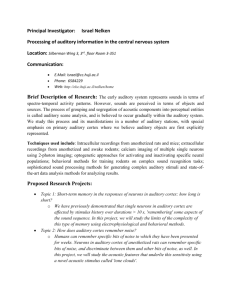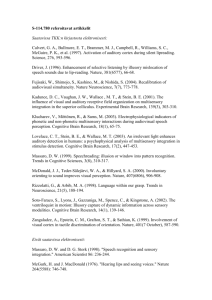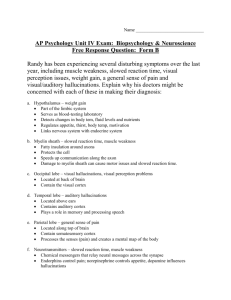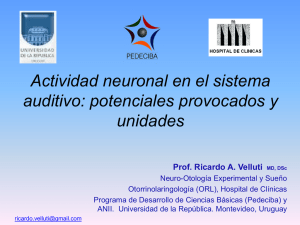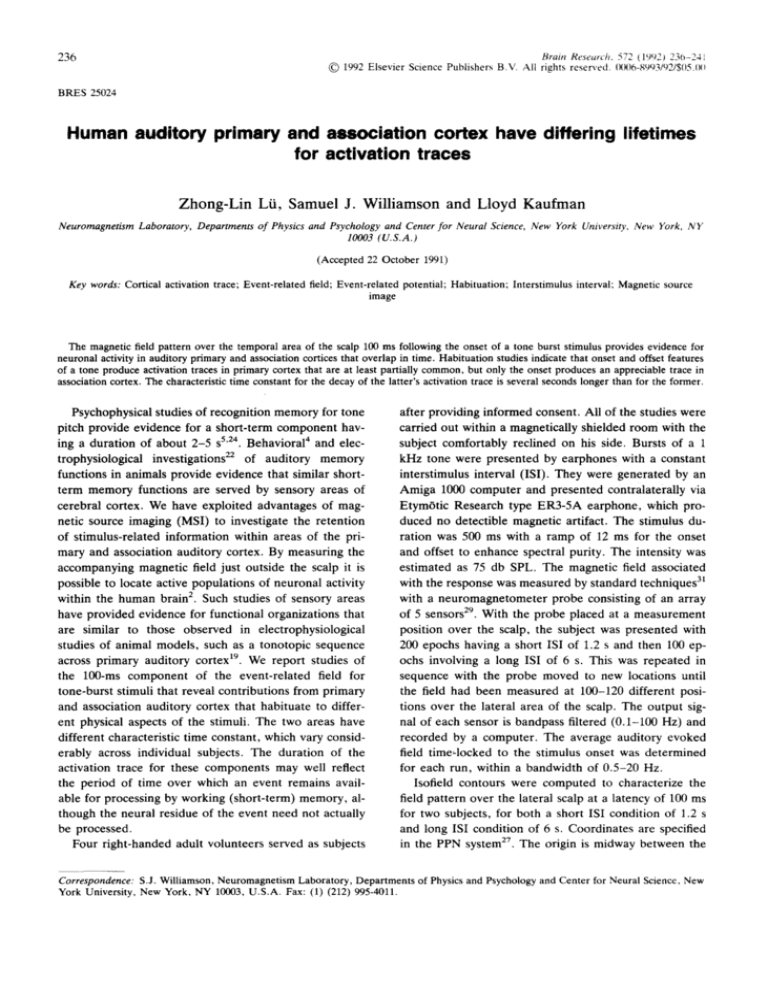
236
Brain Research. 572 (1992! 23(i-24i
© 1992 Elsevier Science Publishers B,V, All rights reserved. {1006-8903/92/$05,01}
BRES 25024
Human auditory primary and association cortex have differing lifetimes
for activation traces
Zhong-Lin Lii, Samuel J. Williamson and Lloyd Kaufman
Neuromagnetism Laboratory, Departments of Physics and Psychology and Center for Neural Science, New York University, New York, NY
10003 (U.S.A.)
(Accepted 22 October 1991)
Key words: Cortical activation trace; Event-related field; Event-related potential; Habituation; Interstimulus interval; Magnetic source
image
The magnetic field pattern over the temporal area of the scalp 100 ms following the onset of a tone burst stimulus provides evidence for
neuronal activity in auditory primary and association cortices that overlap in time. Habituation studies indicate that onset and offset features
of a tone produce activation traces in primary cortex that are at least partially common, but only the onset produces an appreciable trace in
association cortex. The characteristic time constant for the decay of the latter's activation trace is several seconds longer than for the former.
Psychophysical studies of recognition m e m o r y for tone
pitch provide evidence for a short-term component having a duration of about 2-5 s 5'24. Behavioral 4 and electrophysiological investigations 22 of auditory memory
functions in animals provide evidence that similar shortterm m e m o r y functions are served by sensory areas of
cerebral cortex. We have exploited advantages of magnetic source imaging (MSI) to investigate the retention
of stimulus-related information within areas of the primary and association auditory cortex. By measuring the
accompanying magnetic field just outside the scalp it is
possible to locate active populations of neuronal activity
within the human brain 2. Such studies of sensory areas
have provided evidence for functional organizations that
are similar to those observed in electrophysiological
studies of animal models, such as a tonotopic sequence
across primary auditory cortex 19. We report studies of
the 100-ms component of the event-related field for
tone-burst stimuli that reveal contributions from primary
and association auditory cortex that habituate to different physical aspects of the stimuli. The two areas have
different characteristic time constant, which vary considerably across individual subjects. The duration of the
activation trace for these components may well reflect
the period of time over which an event remains available for processing by working (short-term) memory, although the neural residue of the event need not actually
be processed.
Four right-handed adult volunteers served as subjects
after providing informed consent. All of the studies were
carried out within a magnetically shielded room with the
subject comfortably reclined on his side. Bursts of a 1
kHz tone were presented by earphones with a constant
interstimulus interval (ISI). They were generated by an
Amiga 1000 computer and presented contralaterally via
EtymOtic Research type E R 3 - 5 A earphone, which produced no detectible magnetic artifact. The stimulus duration was 500 ms with a ramp of 12 ms for the onset
and offset to enhance spectral purity. The intensity was
estimated as 75 db SPL. The magnetic field associated
with the response was measured by standard techniques 3~
with a neuromagnetometer probe consisting of an array
of 5 sensors 29. With the probe placed at a measurement
position over the scalp, the subject was presented with
200 epochs having a short ISI of 1.2 s and then 100 epochs involving a long ISI of 6 s. This was repeated in
sequence with the probe moved to new locations until
the field had been measured at 100-120 different positions over the lateral area of the scalp. The output signal of each sensor is bandpass filtered (0.1-100 Hz) and
recorded by a computer. The average auditory evoked
field timeqocked to the stimulus onset was determined
for each run, within a bandwidth of 0.5-20 Hz.
Isofield contours were computed to characterize the
field pattern over the lateral scalp at a latency of 100 ms
for two subjects, for both a short ISI condition of 1.2 s
and long ISI condition of 6 s. Coordinates are specified
in the PPN system 27. The origin is midway between the
Correspondence: S.J. Williamson, Neuromagnetism Laboratory, Departments of Physics and Psychology and Center for Neural Science. New
York University, New York, NY 10003, U.S.A. Fax: (l) (212) 995-4011.
237
anterior extremum. The field pattern can be explained if
we assume that one field extremum of a second neuronal
source overlaps that of N100m in the posterior region,
and the other extremum lies near the ear. For convenience we shall refer to the contribution of this second
source, which becomes significant only for long latencies
with this paradigm, as the latent component and denote
it by L100m. This terminology is based on the definition
of latent as 'not apparent but capable of being expressed'.
Standard procedures were followed to locate the neuronal sources 28. The head was modeled by a sphere of
uniform conductivity, placed at the center of curvature
that describes the inner surface of the skull extending
over an area of 5 cm diameter overlying the source, as
determined from MRIs 12. With the position and orientation of the N100m dipole fixed, a subsequent 2-dipole
fitting program was employed to deduce the L100m dipole. We assumed the N100m dipole's position and orientation remained unchanged and allowed the program
to adjust only its strength and all 5 parameters of the
L100m dipole. To obtain a second estimate for the parameters of both sources, the parameter values provided
by the first fit were used as an initial estimate for the
sources in a two-dipole fitting program, which adjusted
the 10 parameters determining the positions and the orientations of both dipoles. The quality of the fit was gauged
by computing the square of the correlation between the
measured field at each position and the field predicted by
the best fitting dipoles. The two procedures yielded results
periauricular points; the x-axis passes from the origin
through the nasion; the z-axis is perpendicular to both
x-axis and line between the periauricular points and
passes from the origin dorsally to emerge near the vertex; and the y-axis is perpendicular to both x- and z-axes
and passes from the origin outward through the left
hemisphere near the ear canal.
In the short ISI condition (Fig. 1A), field extrema of
opposite polarity were identified at the anterior temporal and parietal ends of the lateral sulcus, for all subjects.
The field emerges from the scalp in the posterior region
and enters in the anterior region, to encircle the neuronal source lying midway between. We denote this component as N100m, the ' m ' indicating it is observed magnetically, and identify it with the classic 100-ms
component of primary auditory cortex originating from
neuronal activity on the superior temporal plane L8']6.
The location and other parameters of the current dipole
source best accounting for its field pattern for three representative subjects are listed in Table I.
Fig. 1B shows the contour map obtained at the moment of peak activity evoked by stimuli with the long
ISI. Two features in this plot should be emphasized. (i)
The pattern extends to the lower region of the plot near
the ear canal where there is no evidence of the classic
N100m component and where the latency at the moment
of peak field is about 10 ms shorter than that of N100m.
(ii) The amplitude of the posterior extremum in the long
ISI condition is much greater than that displayed at the
B
A
16
i
w
•
i
w
ISI-6.0
14
~"
w
w
i
sec
i
J
S:ZL
12
10
8'
N4
2
0
-2
-4
-S
0.1S
*
*
*
*
|
zo
,,
,
,
2
i
*
0.1S
*
*
o
-2-4-,-.-zo
x(~)
|
*
|
|
*
a
|
i
l
i
J
|
-12
x(¢=)
Fig. 1. Isofield contours for subject ZL characterizing the measured field pattern over the left hemisphere 100 ms following the onset of a
tone burst stimulus. Arrows denote the direction of current dipole sources that account for each pattern, with their bases placed at the
dipole's surface location. In the right panels, the upper arrow is the N100m source and the lower arrow is the L100m source. Insets illustrate
response waveforms obtained at the indicated positions. Both waveforms also exhibit a 200 ms component.
238
that differ in placement of each source by only 4 mm.
The current dipole p a r a m e t e r s describing the individual N100m and L100m neuronal sources are listed in Table I, Typically, the L100m dipole was found to lie about
2 cm inferior to that of the N100m dipole, as illustrated
in the magnetic source image of Fig. 2. While dipole
orientations and positions differ b e t w e e n hemispheres,
their positions relative to cortical t o p o g r a p h y are similar. The location of N100m lies within primary auditory
cortex, with intracellular current oriented p e r p e n d i c u l a r
to the surface, as expected for postsynaptic responses of
p y r a m i d a l cells. To our knowledge, neuronal activity giving rise to the L100m c o m p o n e n t has not previously
been localized. Of the six candidate sources that may
contribute to N100 TM, the closest to the L100m source is
Th of Wolpaw and Penry 3°. H o w e v e r , this was thought
to be radially oriented, whereas the L100m clearly has a
strong tangential component.
The m o r e inferior location of L100m places it within
the auditory association cortex 15, with activity extending
into the s u p r a t e m p o r a l sulcus. Using 50 p A . m / m m 2 as an
estimation for the current dipole m o m e n t per unit area
of cortical surface 13, we deduce the areas of cortical involvement producing N100m and L100m as about 200
m m 2 and 100 m m 2, respectively. If L100m has a strong
radial c o m p o n e n t of intracellular current (not detected
magnetically) its total area of activity will exceed this estimate.
The field patterns for individual dipoles revealed a 10-
cation on the scalp where the field has an appreciable
contribution from only the N100m source (near the '-200"
notation in Fig. 1B) and another location where it was
p r o d u c e d by only the L l 0 0 m source ('-100' in Fig. IB).
By placing the probe at one or the other location, the
activity of an individual neuronal source could be monitored. In this way the ISI d e p e n d e n c e of the strengths
of N100m and L100m responses could be independently
m e a s u r e d for the range of ISis between 0.8 and 16 s for
each subject.
It has long been known that the classic N I 0 0 of the
event-related potential ( E R P ) m e a s u r e d at the vertex
exhibits refractory properties, so that amplitudes diminish if stimuli are presented sufficiently soon after an
identical preceding one sa'~7. H o w e v e r , these studies did
not take account of the presence of L100m and so did
not identify the separate contributions of responses having different habituation features. As illustrated in Fig.
3 for both hemispheres of 2 subjects, the amplitude of
L100m reaches its asymptotic value at a much longer ISI
than that of N100m. To obtain these data, several trials
of from 50 to 200 stimuli each were presented with representative ISis before each main recording session began, since animals studies 6'7'25 revealed that habituation
!1
TABLE I
Parameters describing the location x, y, z, orientation ~p, and
strength Q of the current dipole best accounting for the field pattern of the indicated response component
Subject
ZL
(Le~)
Condition
x (cm) y (cm)
z (cm)
~
(degrees)
6.3
6.5
6.6
6.2
6.4
4.4
-140
-143
-111
3.3
9.8
2.8
-6.7
-7.2
-6.0
6.0
6.2
4.2
145
151
114
4.4
7.3
9.1
N100m" 0.8
N100m 1.2
L100m -1.9
4.3
5.2
6.7
5.4
5.9
4.2
-134
-122
-94
11.4
11.4
2.3
N100m" 0.4
N100m -0.4
L100m -1.8
6.9
6.6
5.4
5.9
6.0
4.5
-168
-170
-175
2.3
6.8
5.3
N100m" -0.9
N100m -0.4
L100m -2.50
ZL
(Right) N100m"-0.3
N100m -0.2
Ll00m 1.0
SW
(left)
ws
(left)
Q
(nA.m)
Fig. 2. Deduced locations for neuronal sources that are responsible
for N100m (upper arrow) and L100m (lower arrow), on sagittal
MRIs of the left hemispheres of subject SW. Coordinates are expressed in the PPN system, with a distance of 1 cm between adjacent tics on the axes. The base of each arrow indicates the respective positions, with the ellipse indicating the estimated range of
uncertainty (95% confidence level), and the direction of each arrow specifies the flow of intracellular current. The N100m source
lies within the lateral sulcus, and L100m source lies within 1 cm of
the superior temporal sulcus.
239
240
i
i
,
210
*
A
i
i
i
,
i
Subject : ZL
•L 1 0 0 m
sN100m
N
Left ~emisphere
1
0
0
~
I
/
7
*L100m
Subject: ZL
24o
,sloo=
Ri~--~.ph~=.
200
150
@
120
o*
o
9o
,÷
t60
+ ÷
÷
t20
6o
30
0
320
280
80!
7'
i
,
,
t
0'
,
2
4
6
8
Interstlmulus
200
l
175
eL100m
IN100m i
l
;
,
I
k
I
I
10 12 14 16
I n t e r v a l (see)
!
i
i
I
40
I
18
i
Subject : SW
iLeft Hemisphere
i
0
201
L7!
~xso
LS(
~125
@
L2!
~100
LO(
o
m 75
5O
i
i
2
4
6
8
Interstimulus
. . . . . .
eL100m
.N100m
VN100m
ANI00m
i
i
11
10 12 14
6 18
Interval
. .
Subject: SW
Right H~milphe:e
(sic)
+
75
50
25
0
r
I
2
I
4
6
I
I
a I'o i'2 i'4 i'6 18
Interstimulus
Interval
25
8
I
0
(see)
2
4
6
8
Interstimulue
I
I
10 12 14 16
I n t e r v a l (lec)
18
Fig. 3. Response amplitudes vs ISI over left and right hemispheres for 2 subjects, for tones of 0.5 s duration (N100m = squares; L100m =
circles), 1.2 s (N100m = triangles), and 2 s (N100m = inverted triangles). Insets illustrate the dependence for the N100m offset response for
tones of different duration indicated by the horizontal axis.
can e x t e n d for m a n y m i n u t e s or e v e n hours. W i t h this
p r e p a r a t i o n of the subject, stable results could be obt a i n e d consistently, b o t h w i t h i n a session a n d across sessions o n different days.
W e a k r e s p o n s e s o b t a i n e d with short ISis is a characteristic of h a b i t u a t i o n . This has b e e n d e m o n s t r a t e d in
studies of a n i m a l m o d e l s w h e r e electrodes were placed
directly o n the a u d i t o r y cortex 3'10'20'26. Subcortical as
TABLE II
Parameters for the expression A(1-e-(t-to )/~) that best fit the ISI dependence for the indicated onset response components and tone duration
dependence for the offset component
Brackets indicate the durations, and parentheses indicate standard deviations.
Subject
Hemisphere
Condition
A (fT)
to (s)
r (s)
ZL
Left
L100m [0.5 s]
N100m [0.5 s]
N100m [1.0 s]
126 (0.9)
185 (1.0)
178 (0.4)
-0.2 (0.4)
0.2 (0.2)
0.6 (0.2)
5.0 (0.9)
3.5 (0.4)
3.5 (0.4)
ZL
Right
L100m [0.5 s]
N100m [0.5 s]
155 (0.7)
262 (0.4)
0.0 (0.1)
0.0 (0.2)
5.2 (0.7)
3.3 (0.3)
SW
Left
L100m [0.5 s]
N100m [0.5 s]
154 (0.5)
150 (0.8)
-0.4 (0.3)
0.5 (0.1)
3.9 (0.5)
1.3 (0.2)
SW
Right
L100m
N100m
N100m
N100m
85
126
126
98
-0.4 (0.7)
0.4 (0.2)
1.0 (0.1)
1.9 (0.2)
3.8
1.5
1.3
1.0
[0.5
[0.5
[1.0
[2.0
s]
s]
s]
s]
(1)
(0.4)
(0.7)
(0.8)
(0.8)
(0.3)
(0.2)
(0.2)
240
well as cortical processes play important roles in habituation, as recently summarized by Weinberger 21 although
receptors do not 11'23. Such a decrement in response for
repeated stimulation is but one of four characteristics of
habituation. The other three are increments in response
to: presentation of a different stimulus to demonstrate
that the response to standards is not a result of a change
in the subject's general state (called here 'elevated probe
response'); presentation of the same stimulus following
a period in which stimuli are withheld (spontaneous recovery); and presentation of the same stimulus following an inserted stimulus of a different type (dis-habituation). Therefore, responses were recorded and
separately averaged for a probe stimulus one octave
higher, when inserted between every 5th standard stimulus presented with a 1 s ISI. The probe stimuli evoked
significantly higher averaged N100m and L100m responses than the preceding standards (elevated probe
response). Moreover, the following standard evoked a
stronger response than if the probe had not been present
(dis-habituation). If trains of tones presented with 1.0 s
ISI are separated by 5 s of silence, the averaged responses to the first stimulus of each train is significantly
higher than for the others (spontaneous recovery).
Therefore, the weak responses characterized in Fig. 3
meet the traditional criteria to be classified as examples
of habituation.
We find in all cases that the effect of ISI on response
amplitudes can be described adequately by the expression A(1 e-(t-to)/r), where the amplitude A, time constant r, and time origin to are fitting parameters. We
emphasize that the shape of the curve in each case is determined by a single parameter r. Table II summarizes
the corresponding values of the time constants. Each
subject's left and right hemisphere responses for a given
component have essentially the same respective values.
For a given subject, r is significantly shorter for N100m
than L100m. However, r varies considerably across subjects, indicating marked inter-subject differences in habituation characteristics.
Another important feature of the fitted curves shown
in Fig. 3 is the difference in time origins to for N100m
and L100m responses. The curves for L100m intersect
the horizontal axis near the origin, which corresponds to
the onset of the previous tone (the data are consistent
with to = 0 being the intercept). By contrast, the curves
for N100m have their intercepts at the offset of the previous tone. Fig. 3 shows that to is nearly equal to the
tone duration. This difference in intercepts provides clear
evidence that the N100m is primarily habituated by the
offset of the preceding tone and L100m by the onset.
-
That the offset habituates the N100m onset to the It)llowing tone suggests there may be a reciprocal relationship, viz. that the onset of a tone habituates the offset
response to the same tone. In support of this, Fig. 3 insets show how the offset amplitude increases with tone
duration (with a fixed silent period of 500 ms separating
tones). The dependence is identical to the increase in
amplitude of the onset N100m with increasing ISI, for
tones of short duration. The time constants differ by less
than 0.3 s for each subject.
One natural interpretation of the present results is to
consider the difference between the maximum response
at very long ISI and the observed response at any shorter
ISI as a measure for the existing level of the neuronal
activation trace that was established by responses to previous stimuli and need not be further reactivated 18. Our
data indicate that an adequate empirical description of
this difference has the form of a decaying exponential
Ae -(t-to)n, where ( t - to) is the elapsed time since the
last activation and the parameter r is the lifetime. When
these notions are applied to the habituation characterized by our data, we may infer the decay of the cortical
activation trace for L100m commences near the onset of
the tone stimulus. This suggests that information processing in the corresponding region of association cortex
emphasizes the initial features of the stimulus. By contrast, decay of the activation trace for Nt00m commences after the onset and again after the offset. This
suggests that the activation trace associated with the offset N100m is similar to that for the onset Nt00m, and
both are related to activity in primary cortex. Indeed,
Hari et al. 9 have shown that both onset and offset N100m
responses detected magnetically are in primary cortex,
although the center of neuronal activity for the offset on
the average is about 7 mm anterior to the onset.
The present study provides evidence that decay of the
activation trace in each cortical area can be characterized empirically by a single lifetime for the class of stimuli employed. This is undoubtedly an oversimplification
for describing the details of the relevant physiological
processes, for r characterizes only the rate-limiting step.
Moreover, it is reasonable to expect that the lifetime
may well depend on certain physical aspects of a sound.
This research was supported in part by Grants F49620-88-K-0004
and AFOSR-90-0221 from the Air Force Office of Scientific Research and by support from Silicon Graphics, Incorporated. We
thank N. Chase for support in the MR studies, J. Stephenson for
assistance in recording them, D. Karron for contributions in developing computer analyses of MR images, J.-Z. Wang for help with
computer systems, E. Vitale for assistance with the experiments,
and A. Fregly for helpful encouragement.
241
1 Bak, C., Kofoed, B., Lebech, J., Saermark, K. and Elberling,
C., Auditory evoked magnetic fields from the human brain.
Source localization in a single-dipole approximation, Phys. Len.,
82A (1981) 57-60.
2 Brenner, D., Lipton, J., Kaufman, L. and Williamson, S.J.,
Somatically evoked magnetic fields of the human brain, Science,
199 (1978) 81-83.
3 Buchwald, J.S. and Humphrey, G.L., An analysis of habituation in the specific sensory systems. In Stellar, E. and Sprague,
J.M. (Eds.), Progress in Physiological Psychology, Academic
Press, New York, 1973, pp. 1-75.
4 Colombo, M., D'Amato, M.R., Rodman, H.R. and Gross,
C.G., Auditory association cortex lesions impair auditory shortterm memory in monkeys, Science, 247 (1990) 336-338.
5 Crowder, R.G., Principles of Learning and Memory, Erlbaum,
Hillsdale, 1976.
6 Gerken, G.M. and Neff, W.D., Experimental procedures affecting evoked responses recorded from auditory cortex, Electroencephalogr. Clin. Neurophysiol., 15 (1963) 947-957.
7 Hall, R.D., Habituation of evoked potentials in the rat under
conditions of behavioral control, Electroencephalogr. Clin. Neurophysiol., 24 (1968) 155-165.
8 Had, R., Aittoniemi, K., J~irvinen, M.-L., Katila, T. and Varpula, T., Auditory evoked transient and sustained magnetic fields
of the human brain: localization of neural generators, Exp.
Brain Res., 40 (1980) 237-240.
8a Hari, R., Kaila, K., Katila, T., Tuomisto, T. and Varpula, T.,
Interstimulus interval dependence of the auditory vertex response and its magnetic counterpart: implications for their neural generation, Electroenceph. Clin. Neurophysiol., 54 (1982)
561-569.
9 Hari, R., Pelizzone, M., M~ikel~i,J.P., Hllllstrtim, J., Leinonen,
L. and Lounasmaa, O.V., Neuromagnetic responses of the human auditory cortex to on- and offsets of noise bursts, Audiology, 26 (1987) 31-43.
10 Horn, G., Physiological and psychological aspects of selective
perception. In D.S. Lehrman et al. (Eds.), Advances in the
Study of Behavior, Academic Press, New York, 1965, pp. 155216.
11 Horvath, R.S., Variability of cortical auditory response, J. Neurophysiol., 32 (1969) 1056-1063.
12 Karron, D., Lii, Z.-L. and Williamson, S.J., submitted.
13 Lii, Z.-L. and Williamson, S.J., Spatial extent of coherent sensory-evoked cortical activity, Exp. Brain Res., 84 (1991) 411416.
14 N~iat~inen,R. and Picton, T., The N1 wave of the human electric and magnetic response to sound, Psychophysiology, 24
(1987) 375-425.
15 Pandya, D.N. and Seltzer, B., Association areas of the cerebral cortex, Trends Neurosci., (1982) 386-390.
16 Pantev, C., Hoke, M., Lehnertz, K., LtitkenhSner, B., Anogianakis, G. and Wittkowski, W., Tonotopic organization of the
human auditory cortex revealed by transient auditory evoked
magnetic fields, Electroencephalogr. Clin. Neurophysiol., 69
(1988) 160-170.
17 Picton, T.W., Hillyard, S.A. and Galambos, R., Habituation
and attention in the auditory system. In Keidel, W.D. and Neff,
W.D. (Eds.), Handbook of Sensory Physiology, Vol. 5. Auditory System. Clinical and Special Topics, Springer-Verlag, Berlin, 1976, pp. 343-389.
18 Picton, T.W., Woods, D.L. and Proulx, G.B., Human auditory
sustained potentials. I. The nature of the response, Electroencephalogr. Clin. Neurophsysiol., 45 (1978) 186-197.
19 Romani, G.L., Williamson, S.J., Kaufman, L. and Brenner,
D., Characterization of the human auditory cortex by the neuromagnetic method, Exp. Brain Res., 47 (1982) 381-393.
20 Thompson, R.E and Spencer, W.A., Habituation: a model phenomenon for the study of neuronal substrates of behavior, Psychol. Rev., 73 (1966) 16-43.
21 Weinberger, N.M., Ashe, J.H., Metherate, R., McKenna, T.M.,
Diamond, D.M. and Bakin, J., Retuning auditory cortex by
learning: a preliminary model of receptive field plasticity, Concepts Neurosci., 1 (1990) 91-132.
22 Weinberger, N.M. and Diamond, D.M., Physiological plasticity
in auditory cortex: rapid induction by learning, Prog. Neurobiol., 29 (1987) 1-55.
23 Westenberg, I.S., Paige, G., Golub, B. and Weinberger, N.M.,
Evoked potential decrements in auditory cortex. I. Discretetrial and continual stimulation, Electroencephalogr. Clin. Neurophysiol., 40 (1976) 337-355.
24 Wickelgren, W.A., Associative strength theory of recognition
memory for pitch, J. Math. Psychol., 6 (1969) 13-61.
25 Wickelgren, W.A., Auditory or articulatory coding in verbal
short-term memory, Psychol. Rev., 76 (1969) 232-235.
26 Wickelgren, W.O., Effect of acoustic habituation on clickevoked responses in cats, J. Neurophysiol., 31 (1968) 777-785.
27 WiUiamson, S.J. and Kaufman, L., Advances in neuromagnetic
instrumentation and studies of spontaneous brain activity, Brain
Topography, 2 (1989) 129-139.
28 Williamson, S.J. and Kaufman, L., Analysis of neuromagnetic
signals. In Gevins, A.S. and R6mond, A. (Eds.), Methods of
Analysis of Brain Electrical and Magnetic Signals, Elsevier, Amsterdam, 1987, pp. 405-448.
29 Williamson, S.J., Pelizzone, M., Okada, Y., Kaufman, L.,
Crum, D.B. and Marsden, J.R., Magnetoencephalography with
an array of SQUID sensors. In Collan, H., Berglund, P. and
Krusius, M. (Eds.), 1CECIO: Proc. Tenth International Cryogenic Engineering Conference, Butterworth, Guitdford, England, 1984, pp. 339-348.
30 Wolpaw, J.R. and Penry, J.K., A temporal component of the
auditory evoked response, Electroencephalogr. Clin. Neurophysiol., 39 (1975) 609-620.
31 Yamamoto, T., Williamson, S.J., Kaufman, L., Nicholson, C.
and Llin~is,R., Magnetic localization of neuronal activity in the
human brain, Proc. Natl. Acad. Sci. U.S.A., 85 (1988) 87328736.






